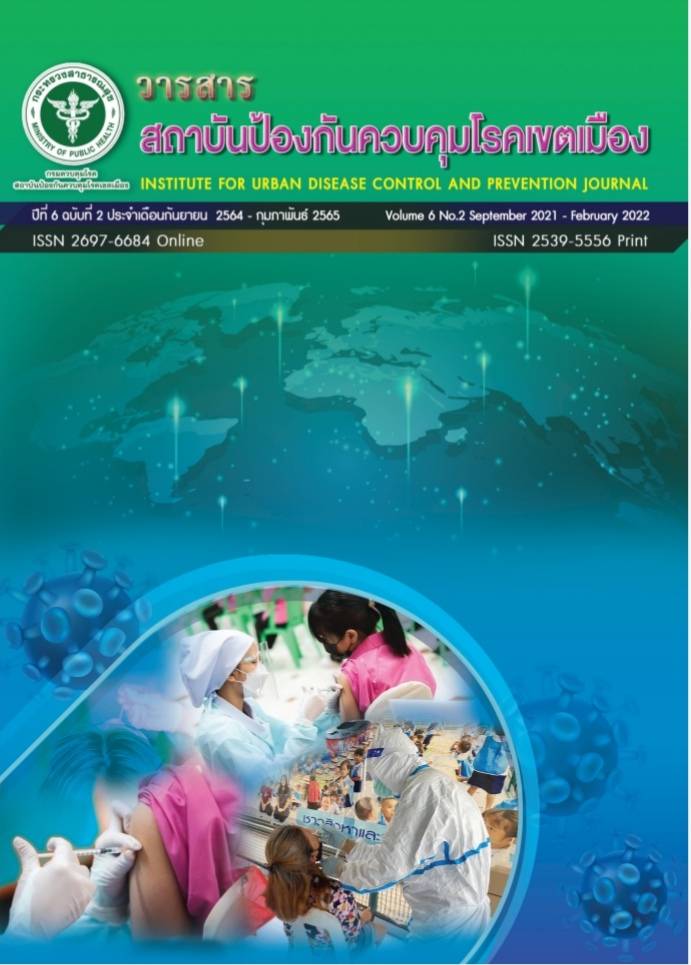รูปแบบการสื่อสารความเสี่ยงด้านสุขภาพในการรับมือภาวะฉุกเฉินด้านสาธารณสุขของชุมชนในจังหวัดสระบุรี กรณีสถานการณ์โรคติดเชื้อไวรัสโคโรนา 2019
Main Article Content
บทคัดย่อ
การวิจัยแบบผสมผสานวิธีครั้งนี้ มีวัตถุประสงค์เพื่อศึกษาองค์ประกอบวัฒนธรรมการสื่อสารด้านสุขภาพในภาวะฉุกเฉินของชุมชนในจังหวัดสระบุรี และพัฒนารูปแบบการสื่อสารความเสี่ยงด้านสุขภาพในการรับมือภาวะฉุกเฉินด้านสาธารณสุขของชุมชนในจังหวัดสระบุรี กรณีสถานการณ์โรคติดเชื้อไวรัสโคโรนา 2019 ดำเนินการศึกษาระหว่างเดือนมิถุนายน – ตุลาคม 2564 กลุ่มตัวอย่างการวิจัยประกอบด้วย ผู้เชี่ยวชาญด้านวิชาการ อาสาสมัครสาธารณสุขประจำหมู่บ้าน ผู้นำชุมชน และประชาชน โดยเลือกแบบเจาะจง และการสุ่มอย่างง่าย เก็บรวบรวมข้อมูลด้วยแบบสัมภาษณ์ กึ่งโครงสร้าง และแบบสอบถามวิเคราะห์ข้อมูลด้วยสถิติเชิงพรรณนา สถิติเชิงอนุมาน และการวิเคราะห์เชิงเนื้อหา ผลการศึกษา พบว่า 1.องค์ประกอบการสื่อสารด้านสุขภาพในภาวะฉุกเฉินของชุมชนในจังหวัดสระบุรี ประกอบด้วย 1) ศักยภาพผู้นำชุมชน 2) นโยบายสุขภาพชุมชน 3) คณะกรรมการสื่อสารความเสี่ยง 4) นักสื่อสารสุขภาพชุมชน 5)วิถีการสื่อสารสุขภาพดั้งเดิม 6) การพัฒนาศักยภาพความรอบรู้ของชุมชน 7) ศูนย์การเรียนรู้ 8) เครือข่ายด้านสาธารณสุข และ 9) การมีส่วนร่วมของชุมชน และ 2. รูปแบบการสื่อสารความเสี่ยงด้านสุขภาพในการรับมือภาวะฉุกเฉินทางสาธารณสุขของชุมชนในจังหวัดสระบุรี ประกอบด้วย 1) แนวคิดของรูปแบบ;(1) การสื่อสารสุขภาพเป็นหน้าที่ของทุกคน (2) สื่อสารข้อเท็จจริงที่มีประโยชน์อย่างรวดเร็ว และ (3) ผสมผสานสื่อชุมชนกับสื่อร่วมสมัย 2) หลักการของรูปแบบ; (1) ส่งเสริมความร่วมมือของภาคีเครือข่าย (2)พัฒนาระบบข้อมูลข่าวสาร (3) ส่งเสริมวัฒนธรรมการสื่อสารสุขภาพ และ (4) สร้างนโยบายการสื่อสารสุขภาพ 3) เป้าหมายของรูปแบบ; (1) ประชาชนมีความรอบรู้ด้านการสื่อสาร (2) ชุมชนมีระบบการบริหารการสื่อสารความเสี่ยงด้านสุขภาพ และ (3) มีเครือข่ายสารสนเทศด้านสุขภาพ 4) กระบวนการของรูปแบบ; (1) จัดตั้งคณะทำงานสื่อสารความเสี่ยงของชุมชน (2) จัดทำข้อกำหนดมาตรการชุมชน (3) ประกาศนโยบายการสื่อสารสุขภาพชุมชน (4) จัดตั้งศูนย์ความรอบรู้ด้านการสื่อสารสุขภาพ (5) กิจกรรมการเผยแพร่ข่าวสาร (6) พัฒนาสื่อและช่องทางการสื่อสาร (7) เสริมสร้างความรอบรู้ด้านการสื่อสารความเสี่ยงด้านสุขภาพให้ประชาชน และ (8) การประเมินผลและการคืนข้อมูล, 5) การประเมินผลรูปแบบ; (1) ความพึงพอใจด้านประโยชน์ของข่าวสาร (2) ความร่วมมือของภาคีเครือข่าย และ (3) ระบบการสื่อสารความเสี่ยง และ 6)เงื่อนไขที่เป็นประโยชน์; (1) มีผู้นำชุมชนเข้มแข็ง (2) มีนักสื่อสารความเสี่ยงสุขภาพ และ (3) มีสื่อและช่องทางการสื่อสารของชุมชน 3. รูปแบบมีความเหมาะสมด้านประโยชน์ (=4.31, S.D.=0.81) และความเป็นไปได้ในการนำรูปแบบไปใช้ปฏิบัติจริงในชุมชนจังหวัดสระบุรี (=3.91, S.D.=0.55) โดยรวมในระดับมากชุมชนเขตเมืองและเขตชนบทมีความคิดเห็นต่อประโยชน์และความเป็นไปได้ของรูปแบบไม่ต่างกัน
Article Details

อนุญาตภายใต้เงื่อนไข Creative Commons Attribution-NonCommercial-NoDerivatives 4.0 International License.
บทความที่พิมพ์ในวารสารสถาบันป้องกันควบคุมโรคเขตเมือง ถือว่าเป็นผลงานวิชาการ งานวิจัยและวิเคราะห์ ตลอดจนเป็นความเห็นส่วนตัวของผู้เขียนเอง ไม่ใช่ความเห็นของสถาบันป้องกันควบคุมโรคเขตเมือง หรือคณะบรรณาธิการแต่ประการใด ผู้เขียนจำต้องรับผิดชอบต่อบทความของตน
เอกสารอ้างอิง
กรมควบคุมโรค กระทรวงสาธารณสุข. รายงานโรคติดเชื้อไวรัสโคโรนา 2019 (COVID-19).
กรุงเทพฯ: โรงพิมพ์ชุมนุมสหกรณ์การเกษตรแห่งประเทศไทย, 2563.
ปัญจวรา บุญสร้างสม. ฝ่าวิกฤตการสื่อสาร ในสถานการณ์โควิด-19 [อินเทอร์เน็ต]. 2564. [สืบค้นเมื่อ 13 ก.ค. 2564]. แหล่งข้อมูล: https://www.thaihealth.or.th/Content/54637-ฝ่าวิกฤตการสื่อสาร ในสถานการณ์โควิด-19.html
Vurro, C. & Perrini, F. (2011) Making the Most of Corporate Social Responsibility Reporting: Disclosure Structure and Its Impact on Performance. Corporate Governance, 11, 459-474.
เมธาวี ดวงจินดา, นงพิมล นิมิตรอานันท์, และศศิธร รุจนเวช. ผลลัพธ์ของโปรแกรมการสื่อสารความเสี่ยงทางสุขภาพในผู้ป่วยกลุ่มเสี่ยงสูงโรคหลอดเลือดสมองที่โรงพยาบาลส่งเสริมสุขภาพตำบล ในจังหวัดสมุทรสาคร. วารสารพยาบาลทหารบก 2559, 17(2), 59-67.
พาหุรัตน์ คงเมือง ทัยสุวรรณ์. การสื่อสารความเสี่ยงกรณีโรคไวรัสโคโรนา 19 COVID-19 Risk Communication [อินเทอร์เน็ต] 2563. [สืบค้นเมื่อ 10 ก.ค. 2564]. แหล่งข้อมูล: https:// sasuk.fph.tu.ac.th/public/images/2020news/ th-img/04/04-20-1/Risk%20%20Com-COVID19-200428%E0%B8%98%E0%B8%A3%E0%B8%A3%E0% B8%A1%E0%B8%A8%E0%B8%B2%E0%B8%AA%E0%B8%95%E0%B8%A3%E0%B9%8C_1.pdf
อรรถสิทธิ์ ขจรรุ่งศิลป์. สื่อสารอย่างไรให้คนไทยเชื่อมั่นและฉีดวัคซีน [อินเทอร์เน็ต] 2564. [สืบค้น เมื่อ 12 ก.ค. 2564]. แหล่งข้อมูล: https://tdri.or.th/2021/06/vaccine-communication/
นงเยาว์ เกษตร์ภิบาล. การทำนายของการปฏิบัติตัวต่อผู้ติดเชื้อและผู้กักกันตัวเอง. คณะพยาบาลศาสตร์ มหาวิทยาลัยเชียงใหม่, 2564.
ภูษณิศา ชัยวิรัตน์นุกูล พัชรินทร์ ศิริวิสุทธิรัตน์ และศุทรา เอื้ออภิสิทธิ์วงศ์. แนวทางการดูแลจิตใจในโรงพยาบาลสนาม ฉบับปรับปรุง ครั้งที่ 1. กองบริหารระบบบริการสุขภาพจิต กรมสุขภาพจิต กระทรวงสาธารณสุข, 2564.
สำนักงานสาธารณสุขจังหวัดสระบุรี. การเฝ้าระวังโรคโควิด-19 (COVID-19) [อินเทอร์เน็ต] 2564.
[สืบค้นเมื่อ 30 ส.ค. 2564]. แหล่งข้อมูล: https://ssjsaraburi.moph.go.th/covid19/index.php
ลัญจกร นิลกาญจน. วัฒนธรรมความเชื่อ กับการจัดการศรัทธาของชุมชน. วารสารนาคบุตรปริทรรศน์ มหาวิทยาลัยราชภัฏนครศรีธรรมราช 2561, 10(2), 11-20.
Creswell, J. W. A concise introduction to mixed methods research. Thousand Oaks, C.A. : Sage Publications, 2015.
กมลพิพัฒน์ ชนะสิทธิ์ และประสพชัย พสุนนท์. การสุ่มตัวอย่างและการผสานข้อมูลตามแบบแผนการวิจัยแบบผสมวิธี. วารสารวิชาการมหาวิทยาลัยธนบุรี 2561, 12(29), 147-158.
เบญจา ยอดดำเนิน-แอ็ตติกจ์. การวิเคราะห์ข้อมูลเชิงคุณภาพ : การจัดการข้อมูลการตีความและการหาความหมาย. นครปฐม : สำนักพิมพ์ประชากรและสังคม สถาบันวิจัยประชากรและสังคมมหาวิทยาลัยมหิดล, 2552.
Keeves, Peter J. “Model and Model Building,” Educational Research Methodology and Measurement : An International Handbook. Oxford : Pergamon Press, 1988.
Likert, Rensis. “The Method of Constructing and Attitude Scale”. In Reading in Fishbeic,
M (Ed.), Attitude Theory and Measurement (pp. 90-95). New York: Wiley & Son, 1967.
Krejcie, R. V. & Morgan, D. W. Determining Sample Size for Research Activities. Educational and Psychological Measurement 1973, 30(3), page 607-610.
พวงรัตน์ ทวีรัตน์. การสร้างและพัฒนาและทดสอบผลสัมฤทธิ์. กรุงเทพมหานคร: สำนักทดสอบทางการศึกษา มหาวิทยาลัยศรีนครินทรวิโรฒ ประสานมิตร, 2543.
วีระศักดิ์ จินารัตน์. การวิเคราะห์ข้อมูลด้วยสถิติเชิงอนุมาน. วารสารวิชาการมหาวิทยาลัยการจัดการและเทคโนโลยีอีสเทิร์น 2557, 11(2), 80-85.
ณัฐวุฒิ กกกระโทก และพุฒิพงศ์ สัตยวงศ์ทิพย์. ผลของโปรแกรมสื่อสารความเสี่ยงด้านสุขภาพต่อแรงจูงใจเพื่อป้องกันอันตรายจากการใช้สารเคมีกำจัดศัตรูพืชของเกษตรกรผู้ปลูกข้าว อำเภอหนองหงส์ จังหวัดบุรีรัมย์. วารสารชุมชนวิจัย 2562, 13(1), 239-250.
จงกลณี ตุ้ยเจริญ, ณิชกานต์ วงษ์ประกอบ, กฤตกร หมั่นสระเกษ และธิดารัตน์ นิ่มกระโทก. การรับมือกับไวรัสโคโรนา COVID-19 ในงานสาธารณสุขมูลฐาน. วารสารวิทยาศาสตร์สุขภาพ วิทยาลัยพยาบาลบรมราชชนนี สรรพสิทธิประสงค์ 2563, 4 (3), 1-20.
เจริญเนตร แสงดวงแข. ผลลัพธ์การสร้างนักสื่อสารชุมชนท้องถิ่นเพื่อเสริมสร้าง จิตสำนึกด้านการอนุรักษ์ทรัพยากรป่าชายเลน ตำบลหัวเขา อำเภอสิงหนคร จังหวัดสงขลา.วารสารศาสตร์ 2563, 13 (3), 40-83.
Dainton, M. and Zelley, E.D. Applying Communication Theory for Professional life. California: Sage, 2005.
เมธาวี จำเนียร และเมธี แก้วสนิท. การสื่อสารสุขภาพเพื่อสร้างเสริมสุขภาวะที่ดีของคนในชุมชน. สมาคม สถาบัน อุดมศึกษาเอกชนแห่งประเทศไทย ในพระราชูปถัมภ์ สมเด็จพระเทพรัตนราชสุดาฯ สยามบรมราชกุมาร 2561, 24(2), 155-166.
นงพิมล นิมิตรอานันท์ ศศิธร รุจนเวช และจุฑารัตน์ ผู้พิทักษ์กุล. รูปแบบการสื่อสารความเสี่ยงทาง
สุขภาพโรคหลอดเลือดสมอง ตามมิติวัฒนธรรมของกลุ่มชาติพันธุ์ไทยทรงดำ:กรณีศึกษาชุมชนหนึ่งในจังหวัดนครปฐม. วารสารคณะพยาบาลศาสตร์ มหาวิทยาลัยบูรพา 2562, 27(2), 80-92.
พวงชมพู ไชยอาลา แสงรุ่งเรืองโรจน. การสื่อสารแบบมีส่วนร่วม: กลไกในขับเคลื่อนแนวคิด สู่การปฏิบัติภายใต้กระบวนทัศน์การพัฒนาแบบทางเลือก. มนุษยศาสตร์ สังคมศาสตร์ 2556, 30 (2), 23-42.
พันธุ์นภา กิตติรัตนไพบูลย์ และแพรว ไตลังคะ. มุมมองด้านสุขภาพจิตและจิตสังคม ของการระบาด COVID -19. กรมสุขภาพจิต กระทรวงสาธารณสุข, 2563.
ชาตรี แมตสี่ และศิวิไลซ์ วนรัตน์วิจิตร. การสร้างเสริมความรอบรู้ด้านสุขภาพ: จากแนวคิดสู่การปฏิบัติ. วารสารวิทยาลัยพยาบาลบรมราชชนนี อุตรดิตถ์ 2560, 9(2), 96-111.


